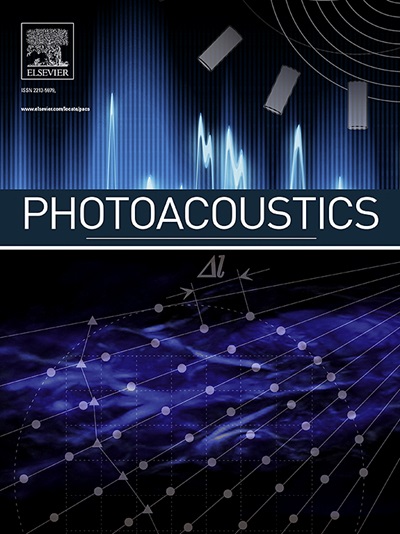基于扩散方程的光声层析自监督光通量校正网络。
IF 6.8
1区 医学
Q1 ENGINEERING, BIOMEDICAL
引用次数: 0
摘要
深度学习(DL)在定量光声断层扫描(QPAT)成像中估计生物组织的吸收系数分布方面显示出前景,但其应用受到缺乏监督网络训练的基础真理的限制。为了解决这个问题,我们提出了一种基于dl的光通量校正方法,该方法只使用原始PAT图像进行网络训练。我们的自监督QPAT网络模型,我们称之为SQPA-Net,在损失函数中引入了基于扩散方程的光影响估计,从而指导模型学习组织内光声传输的隐式表示。仿真和小动物成像实验验证了该方法的有效性和高效性。与目前基于dl的方法和传统的迭代校正方法相比,本文提出的SQPA-Net获得了更好的光通量校正结果,并显著缩短了处理时间。本文章由计算机程序翻译,如有差异,请以英文原文为准。
Self-supervised light fluence correction network for photoacoustic tomography based on diffusion equation
Deep learning (DL) shows promise in estimating the absorption coefficient distribution of biological tissue in quantitative photoacoustic tomography (QPAT) imaging, but its application is limited by a lack of ground truth for supervised network training. To address this issue, we propose a DL-based light fluence correction method that only uses the original PAT images for network training. Our self-supervised QPAT network model, which we termed SQPA-Net, introduces light fluence estimation based on diffusion equation to the loss function, and thus guides the model to learn an implicit representation of photoacoustic light transport within tissue. Simulation and small animal imaging experiments demonstrate the effectiveness and efficiency of our method. Compared to current DL-based methods and traditional iterative correction method, the proposed SQPA-Net achieves better light fluence correction results and significantly reduces the processing time.
求助全文
通过发布文献求助,成功后即可免费获取论文全文。
去求助
来源期刊

Photoacoustics
Physics and Astronomy-Atomic and Molecular Physics, and Optics
CiteScore
11.40
自引率
16.50%
发文量
96
审稿时长
53 days
期刊介绍:
The open access Photoacoustics journal (PACS) aims to publish original research and review contributions in the field of photoacoustics-optoacoustics-thermoacoustics. This field utilizes acoustical and ultrasonic phenomena excited by electromagnetic radiation for the detection, visualization, and characterization of various materials and biological tissues, including living organisms.
Recent advancements in laser technologies, ultrasound detection approaches, inverse theory, and fast reconstruction algorithms have greatly supported the rapid progress in this field. The unique contrast provided by molecular absorption in photoacoustic-optoacoustic-thermoacoustic methods has allowed for addressing unmet biological and medical needs such as pre-clinical research, clinical imaging of vasculature, tissue and disease physiology, drug efficacy, surgery guidance, and therapy monitoring.
Applications of this field encompass a wide range of medical imaging and sensing applications, including cancer, vascular diseases, brain neurophysiology, ophthalmology, and diabetes. Moreover, photoacoustics-optoacoustics-thermoacoustics is a multidisciplinary field, with contributions from chemistry and nanotechnology, where novel materials such as biodegradable nanoparticles, organic dyes, targeted agents, theranostic probes, and genetically expressed markers are being actively developed.
These advanced materials have significantly improved the signal-to-noise ratio and tissue contrast in photoacoustic methods.
 求助内容:
求助内容: 应助结果提醒方式:
应助结果提醒方式:


